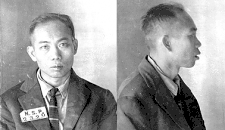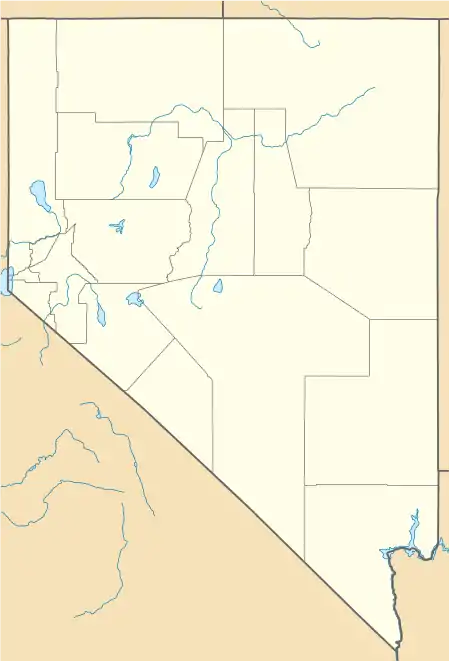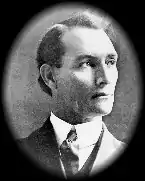Gee Jon
Gee Jon (c. 1895 – February 8, 1924) was a Chinese national who was the first person in the United States to be executed by lethal gas.[1] A member of the Hip Sing Tong criminal society from San Francisco, California, Gee was sentenced to death for the murder of an elderly member from another gang in Nevada.[2] An unsuccessful attempt to pump poison gas directly into his cell at Nevada State Prison led to the development of the gas chamber.[3]
Gee Jon | |
|---|---|
 Nevada State Prison mug shot | |
| Born | c. 1895 |
| Died | (aged 29) Carson City, Nevada, United States |
| Nationality | Chinese |
| Criminal status | Executed at Nevada State Prison on February 8, 1924 |
| Conviction(s) | First degree murder – 1921 |
| Criminal penalty | Death by lethal gas |
Background
Gee Jon was born of Cantonese descent in the Qing Dynasty (now China ) around 1895. He immigrated to the United States between 1907 and 1908 and spent most of his life at San Francisco's Chinatown in California.[2][4] Gee became a member of the Hip Sing Tong society,[2] which dealt in narcotics and liquor. In 1922, territorial disputes with the rival Bing Kong Tong society led to the outbreak of hostilities.[4]
Death of Tom Quong Kee

Tom Quong Kee was a 74-year-old laundry proprietor who was a member of the Bing Kong Tong in Mina, Nevada. Hughie Sing, his American-educated apprentice of two years, pointed Kee out as a target for Gee. During the night of August 27, 1921, Gee knocked on the door of Kee's residence while armed with a Colt .38 revolver. Gee fatally shot Kee, who answered the door in his pajamas. Unlike many other Tong killings, Gee and Sing were apprehended.[4][5]
Trial and sentencing
Gee and Sing were defended by attorneys James M. Frame and Fiore Raffetto.[6] Gee and Sing were both convicted and sentenced to death in the District Court of Mineral County, Nevada. Sing's sentence was commuted to life imprisonment because he was only nineteen years old and Gee had committed the shooting itself.[2] A bill authorizing the use of lethal gas had passed the Nevada State Legislature in 1921, making Gee eligible to become the first person to be executed by this method.[7] Frame argued that Gee's sentence constituted cruel and unusual punishment, but his appeal was denied.[8] The Supreme Court of Nevada instead complimented the state legislators for "inflicting the death penalty in the most humane manner known to modern science."[7] Raffetto unsuccessfully filed a writ of certiorari with the U.S. 9th Circuit Court of Appeals in San Francisco.[6] Gee was incarcerated in Nevada State Prison at Carson City.[9]
Execution

The California Cyanide Company of Los Angeles, California, was the only distributor of liquid cyanide in the western United States and refused to deliver it to Carson City over liability concerns. The poison was used to eradicate pests from citrus groves in California. Warden Denver S. Dickerson sent his assistant Tom Pickett to Los Angeles to personally pick up 20 pounds of lethal gas, which was contained in a mobile fumigating unit that cost $700. Four guards who did not want to participate in the process had resigned.[10] The officials first attempted to pump poison gas directly into Gee's cell while he was sleeping,[7] but without success because the gas leaked from the cell.[3]
A makeshift gas chamber was set up at the butcher shop of the prison.[9] At least one cat was used to test the lethal effectiveness of the chamber.[11] Gee was strapped onto a chair in the chamber, which was eleven feet long, ten feet wide, and eight feet high.[2] A small window next to the wooden chair allowed witnesses to look inside.[9] Attendees included news reporters, public health officials, and representatives of the U.S. Army.[10] Gee wept as he was placed on the chair until the captain of the guards told him to "Brace up!"[12] At 9:40 a.m. on February 8, 1924,[10] the pump sprayed four pounds of hydrocyanic acid into the chamber.[2] The weather was cold and humid.[10] Because an electric heater failed, the chamber was 52 degrees Fahrenheit instead of the ideal 75 degrees, causing some of the acid to form a puddle on the floor. Gee appeared to lose consciousness in about five seconds, with his head continuing to nod up and down for six minutes.[2] He was completely motionless after ten minutes. Some of the witnesses momentarily thought they smelled the odor of almond blossoms, a telltale sign of cyanide, leaking from the chamber. The warden had the witnesses cleared from the area. At about 10 a.m., a vent was opened and a fan was turned on to discharge the poison gas.[10] The prison staff waited for the remaining puddle of hydrocyanic acid to evaporate before cleaning up the chamber.[13] Gee's body was removed from the chamber at 12:20 p.m. and taken to the prison hospital. A group of seven doctors pronounced him dead, but did not conduct an autopsy on the body out of concern that some remaining gas could be released.[10] Gee was 29 years old when he died.[1]
Reaction
The Nevada State Journal proclaimed, "Nevada's novel death law is upheld by the highest court — humanity." However, the San Jose Mercury News printed, "One hundred years from now Nevada will be referred to as a heathen commonwealth controlled by savages with only the outward symbols of civilization."[10]
Warden Dickerson reported to Nevada governor James G. Scrugham and the legislature his opinion that the use of lethal gas was impractical and that he thought execution by firing squad was still the best method of execution.[2]
See also
References
- "Nevada State Prison Inmate Case Files: Gee Jon". Nevada State Library and Archives. July 11, 2003. Archived from the original on May 27, 2008. Retrieved November 3, 2010.
- Reid, John Bevis; James, Ronald Michael (2004). Uncovering Nevada's Past: A Primary Source History of the Silver State. University of Nevada Press. p. 108. ISBN 9780874175677. Retrieved November 3, 2010.
- "Descriptions of Execution Methods: Gas Chamber". Death Penalty Information Center. 2010. Retrieved November 3, 2010.
- Daniels, Roger (1988). Asian America: Chinese and Japanese in the United States since 1850. University of Washington Press. p. 85. ISBN 9780295801186. Retrieved November 3, 2010.
- Christianson, Scott (2010). The Last Gasp: The Rise and Fall of the American Gas Chamber. University of California Press. p. 1. Retrieved November 3, 2010.
Gee Jon.
- Chan, Loren (Summer 1975). "Example for the Nation: Nevada's Execution of Gee Jon". Nevada Historical Society Quarterly. 18 (2): 90–106. Retrieved November 8, 2010.
- Gerber, Rudolph Joseph; Johnson, John M. (2007). The Top Ten Death Penalty Myths: The Politics of Crime Control. Greenwood Publishing Group. pp. 9–10. ISBN 9780275997809. Retrieved November 3, 2010.
- Palmer, Louis J. (2001). Encyclopedia of Capital Punishment in the United States. McFarland & Company. p. 315. ISBN 9780786409440. Retrieved November 3, 2010.
- Bryant, Clifton D. (2003). Handbook of Death and Dying. SAGE Publications. pp. 362–363. ISBN 9780761925149. Retrieved November 3, 2010.
- Christianson, Scott (2010). Fatal Airs: The Deadly History and Apocalyptic Future of Lethal Gases That Threaten Our World. ABC-CLIO. pp. 49–51. ISBN 9780313385520. Retrieved November 3, 2010.
- Chan, Loren (1976). Example for the Nation: Nevada's Execution of Gee Jon. The Life, influence, and the role of the Chinese in the United States, 1776-1960. Chinese Historical Society of America. p. 109. Retrieved November 8, 2010.
- Vila, Bryan (1997). Capital Punishment in the United States: A Documentary History. Greenwood Press. pp. 78–79. ISBN 9780313299421. Retrieved November 3, 2010.
- Banner, Stuart (2002). The Death Penalty. Harvard University Press. p. 198. ISBN 9780674020511. Retrieved November 3, 2010.
Further reading
- Bohm, Robert M. (1999). Deathquest: An Introduction to the Theory and Practice of Capital Punishment in the United States. Anderson Publishing. ISBN 0-87084-212-9. OCLC 40480924.
External links
- 1924: Gee Jon, debuting the gas chamber at ExecutedToday.com
- State of Nevada v. Gee Jon, 211 P. 676 - 1923
- Gee Jon's chair at themobmuseum.org
- Gee Jon at Findagrave.com